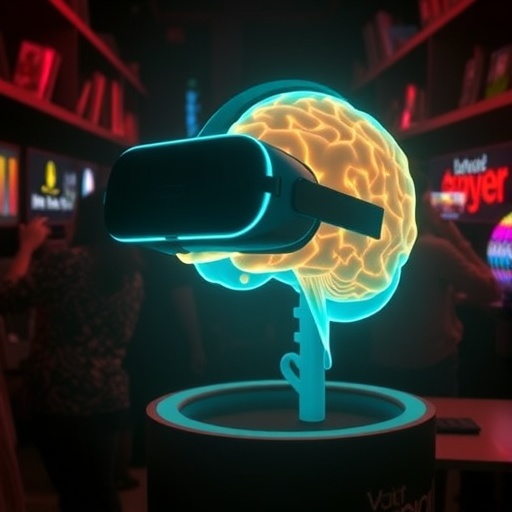In the quest to unravel the complex mechanisms underlying methamphetamine addiction, researchers have turned to cutting-edge technologies to deepen our understanding of craving—a pivotal driver of relapse. A groundbreaking study published in BMC Psychiatry introduces an innovative use of virtual reality (VR) to explore the intricate relationship between cue-induced craving and withdrawal craving in individuals diagnosed with methamphetamine use disorder (MUD). This pioneering work not only casts new light on craving dynamics but also opens promising avenues for immersive therapy design.
Methamphetamine dependence is notoriously difficult to treat, largely due to intense craving experiences that often precipitate relapse. Traditional assessment methods have struggled to capture the nuanced interplay between withdrawal-induced craving—the aversive state during abstinence—and craving triggered by environmental cues associated with drug use. The study in question leverages VR technology to simulate highly controlled, yet lifelike, drug-related scenarios in order to evoke and measure craving responses with unprecedented precision.
The study recruited 150 male participants diagnosed with MUD, all of whom underwent comprehensive evaluations that encompassed demographic profiling as well as addiction severity assessments. Withdrawal craving levels were quantitatively measured using the Visual Analogue Scale (VAS), a well-validated psychometric tool capturing subjective craving intensity. The VR paradigm exposed participants to three distinct environments: a neutral setting devoid of drug stimuli, a scene featuring methamphetamine paraphernalia, and finally, a drug-use scenario designed to closely mimic real-life consumption contexts.
Remarkably, participants exhibited significantly elevated craving responses in the drug-use VR setting compared to both the neutral and paraphernalia scenes. The intensity of cue-induced craving in this immersive environment surpassed even the baseline withdrawal craving reported before VR exposure. This finding underscores the potent role of contextual cues in amplifying craving, and it validates the VR paradigm as an effective method for eliciting authentic craving experiences that may be difficult to capture in traditional laboratory settings.
Further analysis revealed a positive correlation between withdrawal craving scores and cue-induced craving across all virtual environments. Such a relationship implies that the subjective experience of craving during abstinence is closely intertwined with reactivity to external triggers. These data support theoretical models positing that withdrawal states do not act in isolation but rather interact dynamically with environmental cues to exacerbate the risk of drug-seeking behaviors.
Additionally, both types of craving—withdrawal and cue-induced—were positively associated with scores on a standardized MUD severity scale. This correlation suggests that individuals with more severe addiction profiles are prone to experiencing heightened craving responses regardless of the context, emphasizing the importance of craving as a central construct in addiction pathology. Intriguingly, withdrawal craving also correlated positively with methamphetamine dosage and the duration of abstinence, indicating a complex, possibly bidirectional relationship between physiological dependence and craving phenomenology.
The implications of these findings extend well beyond theoretical enrichment. The VR-based cue exposure paradigm offers a powerful translational platform for developing and refining behavioral interventions. By precisely identifying which scenarios elicit the strongest craving responses, clinicians can tailor immersive therapies aimed at desensitizing patients to high-risk cues, thus potentially reducing relapse likelihood. The immersive nature of VR allows for safe and controlled exposure, circumventing ethical concerns related to real-world drug cue confrontations.
Moreover, this approach aligns with the growing trend in psychiatry and addiction medicine towards personalized, technology-driven treatments. By harnessing VR’s capacity for creating customizable, repeatable scenarios, clinicians can monitor craving trajectories over time, adjust therapeutic intensity, and enhance patient engagement. Such real-time data collection could facilitate adaptive treatment algorithms that respond to individual craving patterns and addiction severity.
The study also contributes to a nuanced understanding of the addiction cycle. By elucidating the bidirectional links between withdrawal craving and cue-induced craving, it highlights the multifactorial nature of relapse triggers. Addiction cannot be effectively addressed without appreciating that internal physiological states and external environmental factors operate conjointly to maintain drug-seeking behavior. This recognition is critical for designing holistic treatment regimens that target both domains simultaneously.
Importantly, the use of male participants exclusively in this study raises considerations regarding the generalizability of findings across genders. Future research would benefit from including diverse participant demographics to explore potential sex differences in cue reactivity and craving dynamics. Such expanded research could tailor interventions even further, acknowledging biological and psychosocial variability.
The technical execution of the VR paradigm also merits attention. By integrating high-fidelity visual cues with interactive scene elements, the researchers ensured that participants experienced a level of immersion sufficient to provoke robust craving responses. This level of sensory engagement marks a significant advancement over traditional cue exposure methods that often rely on static images or verbal scripts, which fail to fully capture the complexity of real-world triggers.
Beyond clinical implications, this study paves the way for experimental research that systematically manipulates specific cue variables to dissect their individual contributions to craving. VR allows for granular control over environmental parameters such as time of day, presence of social actors, and availability of drug paraphernalia, enabling hypothesis-driven investigations into the cognitive and emotional substrates of craving.
In conclusion, the innovative employment of a VR cue exposure paradigm to investigate craving in MUD individuals represents a major stride forward. This approach provides robust evidence of the potent synergistic effects between withdrawal and cue-induced craving and offers tangible pathways for enhancing treatment strategies. As the opioid and stimulant crises continue to challenge public health systems worldwide, such technological integrations into addiction medicine herald a new frontier in combating substance use disorders through precision and personalization.
Subject of Research: The interplay between withdrawal craving and cue-induced craving in individuals with methamphetamine use disorder (MUD), examined through a virtual reality drug cue exposure paradigm.
Article Title: Exploring the relationship between cue-induced craving and withdrawal craving in MUD individuals based on a virtual-reality cue exposure paradigm
Article References: Huang, Q., Chen, X., Tang, Y. et al. Exploring the relationship between cue-induced craving and withdrawal craving in MUD individuals based on a virtual-reality cue exposure paradigm. BMC Psychiatry 25, 525 (2025). https://doi.org/10.1186/s12888-025-06986-y
Image Credits: AI Generated




